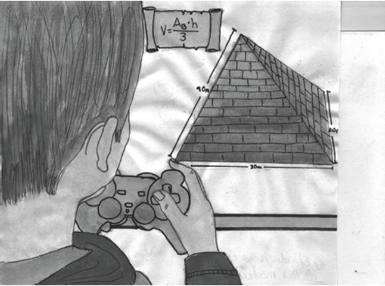The video game as a motivation in mathematics learning
DOI:
https://doi.org/10.31908/grafias.v0i27.1322Keywords:
TIC, geometría, PowerPoint,, didácticaAbstract
This article aims to show the design and construction of a prototype videogame in Microsoft PowerPoint to motivate learning of geometry in 5th grade students, during the written is exposed theoretical basis for the use of video games in the education, showing the methodology for its implementation, from design to construction.
For the design of the game was considered an attractive environment , with elements of much significance in the everyday student , such as a cell to interact with different environmental elements such as messaging, documents , inventories, photographs and maps, plus confront situations where you can find useful knowledge gained in the area of geometry.
The first level of the game is about a scout that wants to get ancient relics and to achieve this he must solve various geometric problems; on his first scout approach requires different inputs to start their adventure in Egypt.
Finally a functionality test is conducted with a fifth grade student who brings us a validation of the accessibility and navigability of the game.
References
Brousseau, G. (1988).Utilité et interet de la didactique pour un profesor de college. Petit X, (21), 47 – 68.
Bruner, J., (1972) El Proceso de educación, México: Ed. Uteha.
Castells, M. (2000). La era de la información, economía sociedad y cultura, La sociedad red. México: Siglo XXI.
Coll, C. (2004). Psicología de la educación y prácticas educativas mediadas por las tecnologías de la información y la comunicación. Sinéctica, 25, 1-24 Consultado el 22 de Noviembre de 2014 y t o m a d o de URL : http://www.redalyc.org/articulo.oa?id=99815899016
Entwistle, N.J., & Waterston, S. (1988). Approaches to study and levels of processing in university students. British Journal of Educational Psychology 58, 258-265.
Gálvez, G. (1994). La geometría, la psicogénesis de las nociones espaciales y la enseñanza de la geometría en la escuela primaria. En: Cecilia Parra e Irma Sanz (Comps) Didáctica de matemáticas. (pp.273 - 299). Buenos Aires: Paidós.
Godino, J.D. y Ruiz F. (2002). Geometría y su didáctica para maestros. Disponible en http://www.ugr.es/~jgodino/edumatmaestros /manual/4_Geometria.pdf
Kolb, D. (1984). Experiential Learning. Englewood Cliff. NJ: Prentice Hall.
Martínez, E. (2008). El juego como escuela de vida: Karl Groos. Revista Miscelánea de Investigación, 22, 7 -22. Disponible en file:///C:/Users/cpe/Downloads/DialnetE l J u e g o C o m o E s c u e l a D e V i d a - 2774872%20(3).pdf
McFarlane, A., y Sakellariou, S. (2002). The role of ICT in science education. Cambridge Journal of Education, 32, (pp.219-232).
Mendiz, A. (2008). Concepto de serious g a m e s . D i s p o n i b l e e n http://www.academia.edu/8373917/Los_seri o u s _ g a m e s_Una_alternativa_a_los_juegos_educativos.
Ministerio de Educación Nacional (2006). Estándares básicos de Competencias en Lenguaje, Matemática, Ciencias y Ciudadanas. Bogotá: Autor.
Padilla, N. (2011). La metodología para el diseño de videojuegos educativos. Tesis doctoral, Universidad de Granada, .España.
Murcia Londoño, E., & Córdoba Vargas, H. (2009). Uso De Las Tics Y Objetos De Aprendizaje Para La Enseñanza De Las Matemáticas en la UCPR. Entre Ciencia e Ingeniería
Prensky,. M. (2010). Nativos e Inmigrantes D i g i t a l e s . D i s p o n i b l e e n http://www.marcprensky.com/writing/Prens k y - NATIVOS%20E%20INMIGRANTES%20 DIGITALES%20(SEK).pdf
Vygotsky, L.S. (1978). Mind in Society. Cambridge, Mass: Harvard University Press.


